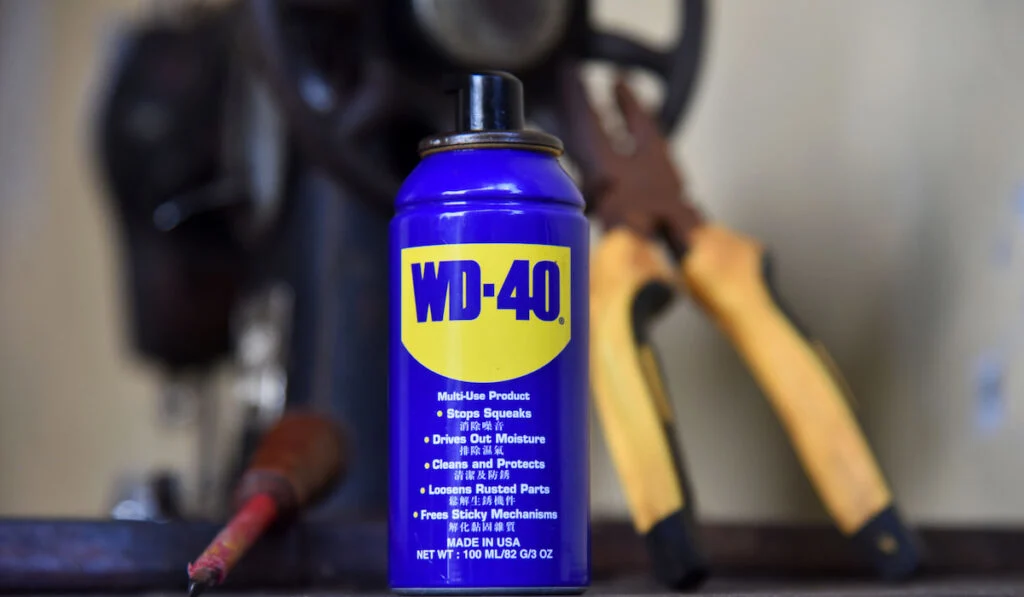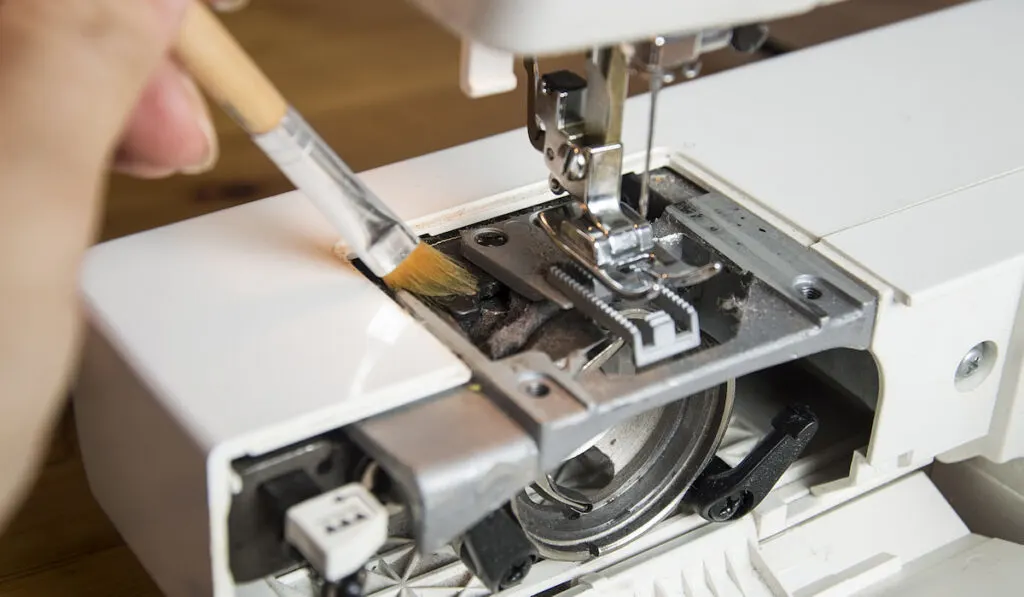WD40 was created in the 1950s as a rust preventative solvent and de-greaser. It quickly became the go-to product in many households.
A sewing machine is a priced possession to many whether it is part of your work, passed down from your mother, or if sewing is one of your favorite hobbies.
WD40 should only be used as a solvent to clean your machine. It must be cleaned off fully to stop it from removing new oil and lubricant applied.WD40 should not be used on a sewing machine as a lubricant. This can damage the machine as it will strip away the lubricant leaving the metal exposed.

A sewing machine is different from other household products. This machine will need specific products and oils for cleaning or lubricating.
WD40 is used for a specific purpose only. It needs to be utilized properly; otherwise, it can damage your machine.
Can WD40 Be Used As A Lubricant On A Sewing Machine?
WD40 stands for water displacement 40. It can be used for rust-prevention, squeak-stopper, or as a cleaner for many products and appliances.
WD40 is used as a lubricant on many different products in and outside the house.
It is a mixture of lubricants that help bring moisture to a part as well as loosening parts that are stuck together.
It can help lubricate annoying squeaky doors, tight hinges, or locks. It can also be used on bikes and cars.
It is the best thing for removing tough marks on surfaces. It can remove crayon marks off walls made by your kids playing around. It can also help loosed Lego pieces and other toys that are stuck together.
This doesn’t work the same when wanting to lubricate your sewing machine. These are heavy-duty machines. They also move too fast for the WD40s ability to lubricate the machine efficiently.
If not utilized properly and for the correct reason, it can end up damaging your machine.
The WD40 will strip away the existing lubricant and oils that are meant to help its parts move smoothly. This will leave the machine dry, leading to metal rubbing on metal.
At the end of the day, WD40 is not a good product to use as a lubricant. Using this product is worse than not using no lubricant at all on your machine.
The best product to use for a lubricant is sewing machine oils such as Singer Sewing Machine Oil. They are inexpensive and can be purchased in most stores or online.
There are some instances when your sewing machine may be needing a substitute lubricant in an emergency.
If you can’t get your hands on sewing machine oil, then the next best alternative is tri-flow. This can be used for many other purposes around the house.

Clock oil can be used only for metal parts that are touching each other.
The oils that should never be applied to your sewing machine are 3-in 1 oil and WD40.
What Can WD40 Be Used For On A Sewing Machine?
WD40 should never be utilized as a lubricant, but it works well as a solvent on a sewing machine. It is one of the favorites for cleaning machines along with Liquid Wrench and Kerosene.
An appropriate thing to always do before oiling or cleaning your machine is to read the manual. The manual will list the best products that can be used for your sewing machine.
This is specifically when it comes to using products on the plastic parts of the machine. Some chemicals in this product can cause an adverse reaction or cause the plastic to degrade.
This product helps get rid of any old gummy grease and oil on your sewing machine. If WD40 is used, it must be done properly, and it must be thoroughly cleaned off.
If it is not taken off the machine properly, it will continue dissolving all the oil present on the machine. It will also break down any new oil put onto the machine to help with lubrication.
It can be used as a solvent on many different sewing machines. The sewing machines where WD40 should never be utilized for cleaning are specific industrial sewing machines and long-arm quilting machines.
This is due to these machines having porous bearings where the WD40 cannot be removed easily.
WD40 should also not be used on sewing machines that have plastic parts. This is due to the plastic parts being porous, which will hold onto the WD40. This can lead to further problems.
When WD40 is applied to sewing machines, it must be done carefully. If it is utilized consistently, it can cause the machine to dry out, and it can leave a film.
A sewing machine needs a lot of care when utilizing this product because it needs to move fast and run freely when being used.
- DRIVES OUT MOISTURE: Drives out moisture and quickly dries out electrical systems to eliminate moisture-induced short circuits
- CORROSION INHIBITOR: Acts as a corrosion inhibitor to shield against moisture and other corrosive elements to prevent rust
- FREES AND LOOSENS STICKY PARTS: Frees sticky mechanisms, loosens rust-to-metal bonds and helps release stuck, frozen or rusted metal parts
It should only be applied to parts that are moving. It should not be applied to the surface of the machine as it can damage emblems and decorative details on the sewing machine.
How To Clean My Machine Properly With WD40?
A sewing machine can be degreased nicely with WD40. It needs to be done correctly; otherwise, it can damage the machine.
The WD40 needs to be removed from all parts of the machine.
This can be done by using an air compressor or a can of air and flannel rags. The can of air must be full and have a decent amount of pressure.
This will help remove all the WD40 and the gummy grease it removes.
The first thing to do when cleaning the sewing machine is to open it up. Using the air compressor blow out the lint.
This will help get the smaller pieces of lint out easily that other tools can’t. This is a great tool to use as it will clean the machine thoroughly.
Spray the moving parts of the machine that have a buildup of old grease. Move the parts that the WD40 was applied to. This will help loosen all the grease.
Once the grease is loosening and coming off the machine nicely, it is time to take the WD40 off. Use the air compressor or can or air and blow off the grease and WD40.
Make sure it is blown out properly. There must be no wet spots insight. The WD40 evaporates over time; by using the air compressor, it will evaporate at a much quicker rate.
Make sure to turn the wheel so that all the sides that were sprayed are blown out properly. Patience will be needed for this step as it can take a while to do.
Once that is finished, use the flannel rags to wipe up all the grease and WD40. After this, the machine will need to be blown out again with the air compressor or can of air.
New oil can be applied once the machine is fully cleaned. It is important to apply the correct oil to the sewing machine.
If you are coming across some problems when using the WD40, there are a few things to look at.
It can either be from using too little WD40, the gunk didn’t dissolve properly, or the WD40 and grease weren’t cleaned off the sewing machine well.
Putting more oil on the machine won’t help dissolve and get rid of the WD40 if it was not removed properly. The WD40 needs to be removed for the machine to work efficiently.
You will need to redo all the steps above, or you will need to use the air compressor for longer.
If you are still struggling or are nervous about giving it a try, then it is best to get a professional to clean your sewing machine properly.

Conclusion
It is important to look after your sewing machine properly. The type of products you use to oil or clean your machine can either help or damage it.
If you have given it a go and cleaned it properly, then start it up and see how well it works.
If you are having problems, remember to clean it again with the air compressor until all the WD40 is off.
If you are unsure how to clean the machine properly or don’t have the correct equipment, then it is best to get a professional to do it for you.
The machine will come back working efficiently when handled by someone who has had a lot of experience.
Resources
- http://trashn2tees.blogspot.com/2015/10/why-wd40-is-bad-for-your-sewing.html#
- https://wd40.co.uk/tips-and-tricks/uses-for-wd40/
- http://shesasewingmachinemechanic.blogspot.com/2014/12/using-wd-40-on-sewing-machines.html
- https://www.quora.com/What-is-an-alternative-for-sewing-machine-oil
- https://www.treadleon.net/sewingmachineshop/cleaningmachines/cleaningmachines.html
- https://sewingiscool.com/how-to-clean-sewing-machine/#tab-con-14
- https://sewingmachineclub.com/sewing-machine-oil-substitute/
